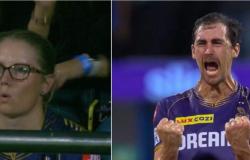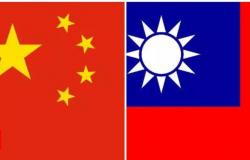The team name is UiO IMB-Biokjemi.
– We couldn’t come up with anything fancier than that, comments team leader, student and research assistant Julie Aarmo Johannessen.
As far as she knows, it is the first time that the Department of Biochemistry at the Department of Basic Medical Sciences is fielding its own team in the Holmenkoll Relay. Among the fifteen participants on the team are also master’s student Aina Louise Cimafranca Haukeland and chief engineer Aumkar Logendran.
The team leader says that the youngest on the team are in their 20s and the oldest in their 40s, and that there are both students and professors on the team. There are eleven girls and four boys, and should someone drop out, they have two runners in reserve.
The stages are distributed and posted on a large board in the lunchroom.
– We are reminded of this daily, she notes.
The aim is to beat the mathematics department
– What is the goal, in terms of results? we wonder
– It is of course to beat the Institute of Mathematics, declares Cimafranca Haukeland. Everyone laughs, because it was meant as a joke. The Department of Mathematics has won the UiO trophy two years in a row.
But UiO IMB-Biokjemi has at least one strong card.
– Aina has won a marathon, says Aumkar Logendran.
– It was a small half marathon in Wales, explains Cimafranca Haukeland. She is very fond of running, and will run the king’s leg of the relay, the stretch from Slemdal school to Besserud.
Aumkar Logendran is considering starting training after Easter.
– Sometimes I run to the bus. It will be almost like training for the shortest stage, he muses. That is the stage he will run.
– I’m in it for the social cause, he asserts.
– The most important thing is that we beat the other team to IMB
– We are in it to do something nice together, and to beat the mathematicians, insists Julie Aarmo Johannessen, and reveals that the team has a couple of other strong cards in addition to Cimafranca Haukeland.
New laugh. Beating the mathematicians is still just nonsense, we understand, because it is actually a completely different team that UiO IMB-Biokjemi is keen to defeat.
– The most important thing is that we beat the other team to IMB, declares the team manager.
– We don’t know who they are, but we are betting on beating them.
The team UiO Mathematical Institute has its 20th anniversary this year. The first time they participated was in 2004. Team leader Christin Borge has been involved since the beginning.
– We run in the A1 mix class, which is the class for mixed teams with the most men. In this class, everyone with a finish time under 1:12:00 is rewarded. We have managed that every single year, she says.
– The fact that we are now at the top at UiO makes it extra fun
In 2019, however, something happened which, according to the team manager, made it even more fun to participate. After the relay, the UiO teams were invited for the first time to a separate celebration with an award for the best UiO team. And here the Institute of Mathematics came in second place. Then followed two years of pandemic. When the relay was organized again in 2022, it was the Mathematical Institute that went home with the walking trophy, a feat that was repeated in 2023 with a finish time of 1.06.11.
– There are so many teams participating, and we are drowning a bit in the crowd. The fact that we are now at the top at UiO makes it extra fun to be involved, notes Borge.
The large walking trophy is clearly visible on a shelf in the break room. Uniforum has come to take pictures of a bunch of the participants with the trophy. Martin Wynn from the corporate sports team at UiO (UiOBIL) has also come to be in the picture, and to talk a little about the relay.
– It was Svein Stølen who took the initiative to create a separate UiO event in connection with the Holmekoll relay, with a trophy for the best UiO team, says Wynn who, in addition to being a board member of UiO-BIL, is employed in the Parks section at UiO .
* Read more in Uniforum: A record number of teams from UiO will participate in the Holmenkoll Relay
Two joint training sessions a week
Three of the participants on the team at the Department of Mathematics, senior lecturer and team leader Christin Borge, research fellow Ola Sande and professor Michael Floater, also take time out for a chat with Uniforum.
We learn that the youngest members of the team are master’s students, and that the oldest member, Michael Floater, is 61 years old and only started running when he was in his 40s.
And on this team, there is apparently no one who has not started training for the relay.
– In March, the weekly joint training was extended to twice a week. In the last week before Easter, ten took part on Tuesday, and five on Thursday, Ola Sande can tell.
– We also spend a lot of time finding the optimal distribution of stages, he adds.
After all, they are mathematicians.
Ola Sande also runs for the sports club Vidar and has participated in a total of 17 marathons.
– But it is fine to have variation in the quality of the runners, he assures and reminds that the Holmenkoll Relay has both long and short stages.
– Like going on the May 17 train, only that you run
– The Holmenkoll relay has motivated many at the institute to start running, comments Borge. She herself is not really that fond of running, but she does not want to miss the Holmenkoll Relay.
– This is spring’s most beautiful adventure.
– Participating in the Holmekoll relay is like going on the May 17 train, only that you run, adds Sande.
The three mathematicians believe that the institute will be able to keep the walking trophy, but they point out that it is not just about winning. The social aspect is just as important, they believe.
There is a lot of talk about the Holmenkoll relay at the institute these days, and it is not only the participants on the winning team who are involved, according to the three.
– We also have a second team, and many at the institute have been involved in the past. We have got a relay environment, and it gets more and more fun every year, notes Borge.
– It is not too late to sign up
In recent years, UiO has fielded between 40 and 50 teams.
– It is not too late to sign up, emphasizes Martin Wynn.
The relay itself has no registration deadline, but the prices for participation rise the closer you get to the relay. For the Business Sports Team, it is also nice to get an overview of the UiO participants as quickly as possible. The red t-shirts with the UiO logo that the UiO teams wear must be ordered in time. Wynn describes the t-shirt that participants receive as a technically good running shirt.
There will also be shopping for the social gathering after the race. The party takes place in the so-called Østhagen, i.e. the part of the university garden in the center which lies along Universitetsgata.
– The party starts at 17 and lasts until approx. at 20, and here it will be style, says Wynn.
There will be waiters in white shirts and free food and mineral water for the participants, and should anyone want something stronger to drink, this will be available for purchase at the bar.
– Get in touch if you don’t have a team to run with
Remember to notify UiOBIL about the registration, urges Wynn.
– And please have UiO in the team name, he adds.
The teams must initially have 15 participants, but if it is not possible to field a full team, one person can run two stages.
– In this case, the organizer recommends that a participant who runs an early stage also runs a late stage, but it is also possible to let a strong runner take two stages in a row, comments Wynn.
And if you don’t have any colleagues to run the relay with, the race isn’t done after all.
– Get in touch, and we will place you on one of the teams that lack participants, encourages Wynn.
He uses the opportunity to do some advertising for UiO’s jogging group right away. Anyone who wants to can train here.
– You do not need to sign up. You just have to show up on Thursdays at 11 at the reception of the Athletica Blindern training center in Frederikkebygningen.
– Most people run mostly to have fun
If you’re not in great shape, it doesn’t matter.
– The Holmekoll relay is a big public event, and most of the teams run mainly to have fun, points out Martin Wynn and reminds that the Holmekoll relay is Norway’s biggest exercise event. Around 60,000 people took part last year, divided into over four thousand teams.
All teams from UiO run in class A1. This means that the UiO teams start at the same time.
– The UiO participants in red t-shirts look good in the crowd. That the Holmenkoll Relay also contributes to making UiO visible is a pleasant side effect, notes Wynn.
Tags: mathematicians run gold biochemists fun
-





